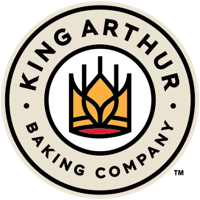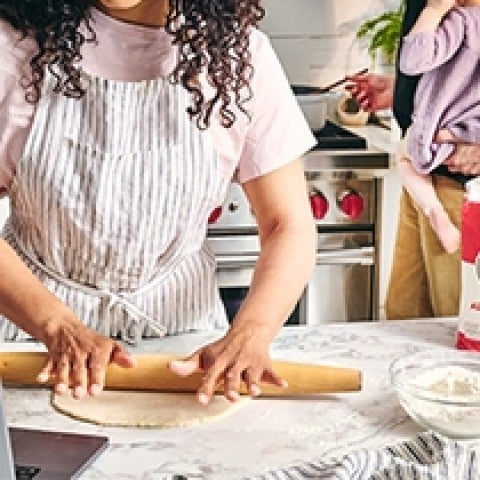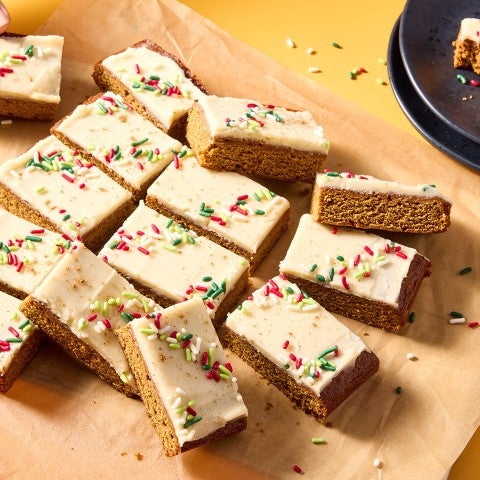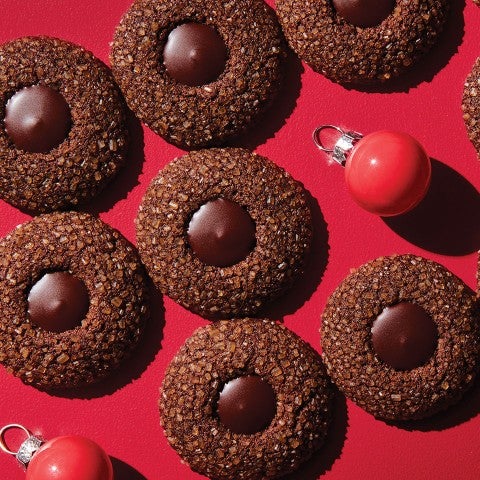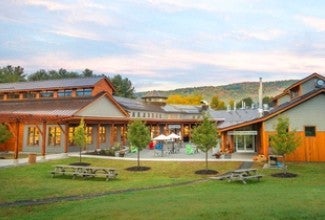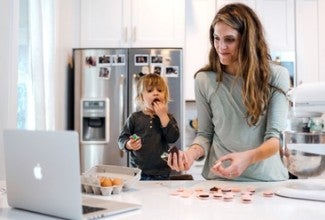Great Gluten-Free Bread is Possible! featuring Aran Goyoaga
Listen to this episode below, or wherever you get your podcasts: Spotify | YouTube | Amazon Music | Apple Podcasts
We’re going gluten-free this week and talking about how to make the best gluten-free bread — because we believe everyone deserves great bread.
Aran Goyoaga, author of the stunning new book The Art of Gluten-Free Bread, joins us to talk about her approach to gluten-free bread baking, including some of her favorite flours and tips and tricks. We break down the dizzying world of gluten-free flours, our tips for making gluten-free sourdough, and the differences between gluten-full and gluten-free bread doughs. And as always, we close out the show with Jessica’s Jess-opinion of the week and the (gluten-free!) recipes she and David are baking.
Recipes and other links from this episode:
- Find Aran’s book: The Art of Gluten-Free Bread
- Learn more about gluten-free flours: Which gluten-free flour should I use?
- Read: How to substitute Gluten-Free Bread Flour for regular flour
- What David’s baking this week: Gluten-Free Chocolate Mousse Cake with Raspberries
- What Jessica’s baking this week: Sunken Berry Almond Cake
- Record your question for our Ask the Bakers segment here!
- This episode is sponsored by Plugra. Learn more about their premium European-style butter at plugra.com.
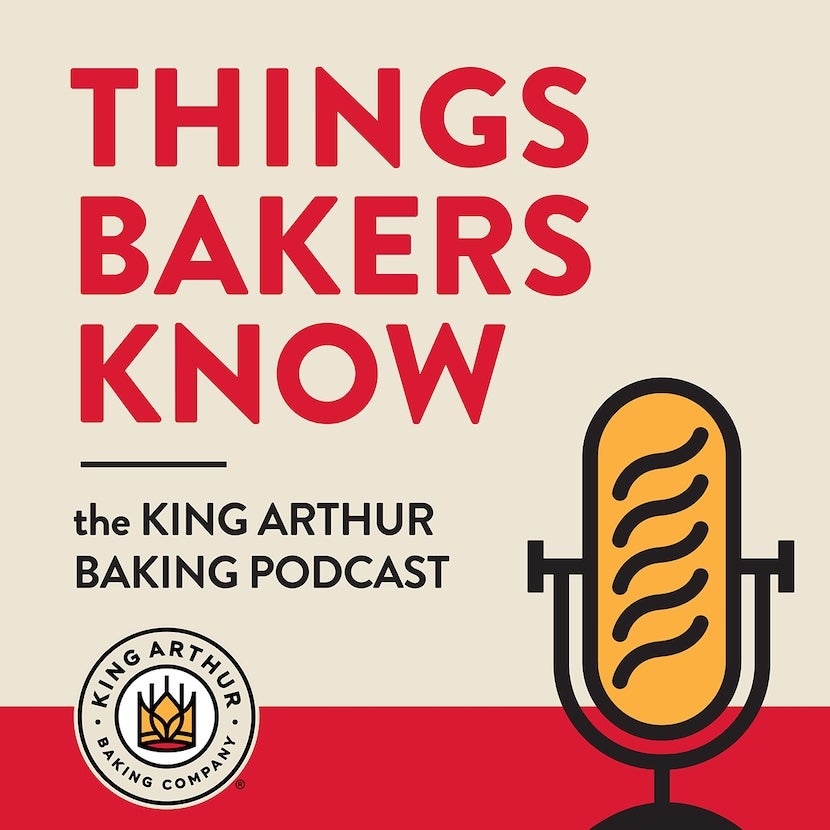
Episode Transcript
David: This season is brought to you by Plugra premium European-style butter, made using a slow churn process. Look for Plugra wherever fine butters are sold.
Gluten-free bread baking is not so dissimilar from glutenous bread baking.
Jessica: And the panic.
David: I mean, the panic applies to all.
Jessica: Absolutely. The panic is universal.
David: From King Arthur Baking Company, this is Things Bakers Know. I'm David Tamarkin, King Arthur's Editorial Director.
Jessica: And I'm Jessica Battilana, King Arthur Staff Editor. And today, David, we are charting a course into unfamiliar waters.
David: Okay. Sounds scary.
Jessica: I hope you brought your life jacket. Since we launched this podcast, we have heard from a lot of listeners, which is great. I love that, especially when they say nice things. We've gotten a lot of feedback. People have left reviews. My producer did tell me about one, a listener who goes by the name Kringla Princess, who said we have terrific personalities. There you have it.
David: Mm. If only she knew us in real life, Kringla Princess. Hey, would hate to disappoint you.
Jessica: Is that your mom? Maybe?
David: Yeah, that's right. But yes, we have heard from listeners and they've asked us for a few things, and what they say they want is more science, more history, more about flat breads and coffee cake.
But maybe most of all, what people want us to talk about is gluten. More specifically the lack of it. They want us to talk more about baking gluten-free.
Jessica: Oh yeah. Lots and lots of comments about gluten-free baking. One listener wrote us, “What a great podcast.” Thank you so much. “I was forced into gluten-free baking with a celiac diagnosis five years ago. King Arthur mixes and flours give me the best results, but would love hints, tricks of the trade or ideas to be successful with gluten-free breads, especially.”
I don't know that much about gluten-free bread baking because I do not bake gluten-free, but fortunately for the listener, the bench of King Arthur is very deep, and it's a company filled with true gluten-free bread experts, and so we wanted to devote on an entire episode to gluten-free bread specifically.
David: Yeah, we're gonna use the phone a friend option a bunch in today's episode because gluten-free baking, especially gluten-free bread baking, which is the subject of this episode, it's challenging and it's not intuitive.
Jessica: No, it's not. If you are a wheat baker, I think the learning curve can be steep. If you're somebody with a new diagnosis of celiac or gluten intolerance, I think it can feel a little bit overwhelming.
But I do think it's worth, you know, every baker learning about gluten-free baking because it's not fringe, right? Like I feel like maybe 15 years ago, like you never heard or you heard of only a few people, maybe 20 years that couldn't or didn't eat wheat and now it's pretty common. I think around 1% of the American population does have a celiac diagnosis and up to 6% have non celiac gluten sensitivity.
And you know, we talk a lot about this on the podcast, about, and at the company, about how baking is like a joyful and inclusive thing to do. But you know, if you're not thinking about gluten-free folks, then you know you're not being that inclusive. So, I'm glad we're doing this episode. I learned a lot and I, I hope it's helpful to listeners, whether, you know, you bake gluten-free for yourself or for the people that you care about.
David: Yeah, I know this from personal experience. Actually, my family is one of those that bakes at every occasion. There's a coffee cake my mom has made for decades that we all expect at every family function.
Jessica: Why don't we have that recipe on the site? We need to.
David: Uh, coming soon.
Jessica: Okay, good.
David: Uh, there's challah at Shabbat. I make pizza for the family every chance I get. But a few years ago, one of my sisters stopped eating gluten because of this sensitivity and the fact that that had on how our family operates was actually pretty huge. All of a sudden, all these recipes that our family gathered around were poisoned. Ruined, poisoned with the knowledge that it would make one of us really sick. And frankly, our family just fell apart and I haven't seen them since. Uh, no, just kidding. But no, we, we really do, we had to rethink what we bake and how we do it. And so one of our go-to recipes now is the Sunken Berry Almond Cake on the King Arthur site.
That's a Samantha Seneviratne recipe that is so good and can be prepared so many different ways to fit any occasion.
Jessica: That's a great recipe.
David: But bread is harder. And I'm remember last year for Thanksgiving, I made the potato rolls from the Big Book of Bread because, I mean, those are just, I think I've mentioned those on the podcast before. It's some, one of the most delicious things a person can bake and eat. And it was, it was kind of actually a bummer because there was someone at the table who couldn't eat these huge, fluffy, delicious rolls. And so I've recently started to teach myself how to bake gluten-free bread and pizza.
And now Jessica, guess what? It's happening.
Jessica: You've leveled up.
David: I've leveled up, but, but actually, and this is not, I'm not, I'm not exaggerating here. Now my sis, my gluten-free sister has to physically protect her gluten-free bread and pizza that I bake for her because everybody wants to taste it. Everybody wants to get in on it. I mean, it's just that good.
Jessica: I mean, well, and that, that is like a real sea change because I feel like when gluten-free bread was first out on the market, I worked, my first job in high school was at a health food store called 18 Carrots. And they sold gluten-free bread there, but it was like a kind of vacuum-sealed styrofoam brick, basically is how I would describe it.
It was awful. The slices were so small, like good luck making a sandwich on that.
David: If everyone who was gluten free was just eating canapes.
Jessica: Yeah, exactly. You're like, I'll have 50 sandwiches, please. And it was so dense and it was really unpleasant. And I think folks tolerated it because there was no alternative, but so much research and development has happened. So much experimentation has happened amongst bakers and the gluten-free bread of yore is not the gluten-free bread of today, like.
David: Totally. A lot has happened. There's, there's legitimately great gluten-free bread now. There's even great gluten-free sourdough bread. There's great crusty artisan-style, gluten-free bread that you could eat without really ever knowing that they don't contain gluten.
Jessica: Yeah. And it, it is truly amazing and I've tried some things that our test kitchen have been working on or our R&D teams have been working on and it's pretty, uh, it's actually pretty astonishing.
But before we go too far down the gluten-free rabbit hole, I wanna talk for a second just about gluten because we are very well versed in talking about gluten 'cause it's what we do all day. But I think for our listeners it might be helpful just, you know, give a little bit of information just about what gluten is and what it does and then yeah.
It sort of sets up the, you know, it sets up the challenge that you're faced with when you're making gluten-free bread, right? And so school's in session, Professor Battilana is here reporting for duty. So a common misconception is that gluten is actually a part of wheat flour, but technically that's not true.
Gluten is formed from wheat flour when water or another liquid is added to it. So I think that's, that's one thing that's worth explaining or clarifying. And then wheat flour contains two proteins necessary to form gluten, glutenin and gliadin. When you add water or another liquid to wheat flour, those proteins are linked together, that creates gluten. It's sort of like a chain of proteins. And then, well, you know what happens next? Like when you start to knead or fold a bread dough.
David: Yeah. When you, right, the reason we knead and fold or vigorously stir a wheat flour based dough is because that's how we get the gluten to continue to develop.
With each fold, with each knead, these proteins bond together stronger and a web of gluten strands that you can actually see if once you've developed them form. And that's what captures the gases that are emitted by yeast. When the yeast feed on the sugars in the flour or the sugars that you've added to the dough, they emit gases and that gluten is what traps them and allows breads to rise and get fluffy.
Jessica: So you could see like why the absence of gluten presents a bit of a problem for bread because it contributes to the bread's rise, obviously. Like that strong gluten network holds that air in. Uh, it's, but also it's crumb, it's size, it's shape, but like it's pretty fundamental. And so you would think that like without gluten, there would be no way to make a good loaf of bread.
David: Because I'm thinking, yeah, what is there to capture? The gas is emitted by the yeast, if not gluten. Right?
Jessica: Right, exactly. And so while it is definitely harder than baking a bread with a wheat flour, and that's why we're talking about the learning curve being steeper, it's still possible to make great gluten-free bread. You just need to use like different processes.
Different flours, different ingredients and techniques, and that's what we're gonna talk a lot about today. In the episode we talk about how like gluten-free bread making has come a long way. And it used to be that all of these gluten-free flours, you know, 'cause there are certainly flours milled from grains that are naturally gluten-free.
And so those flowers were used to make bread along with xantham gum, which is, you know, helps to mimic a lot of what gluten does. That was sort of the old school, like the 1.0 version of gluten-free bread making. But now there's gluten-free wheat starch, which has totally like revolutionized the possibilities for gluten-free flour.
David: So 2.0. Yes. This is actually a very exciting time for gluten-free baking, especially gluten-free bread baking, because as you mentioned, xantham gum was, and is still, used everywhere in gluten-free flours and what xantham gum is doing, it's a binding agent that's, you know, providing elasticity and elasticity is really the thing that you need in bread doughs.
And that gluten often contributes to bread doughs. But now there's something in addition to xanthan gum that people can use and it's gluten-free wheat starch and what that is, it's the, it is legitimately wheat, but all the gluten has been washed off of it. And so it's just giving gluten-free breads much more wheaty flavor and, and wheaty texture because there's actual wheat in it.
It's just, just not glutenous wheat. So. We've tasted the difference between, you know, breads made with gluten-free flours that only have this xantham gum and those that now have this gluten-free wheat starch in it. And it is remarkable. That is this gluten-free wheat starch is, it's like a magic, it's like a magic ingredient.
Yeah. It makes breads that really do feel and taste like wheat bread and yeah, sort of make it indistinguishable. Like this is what I've done with my nephews, uh, who I've had to suffer through some pretty bad gluten-free baking over the past few years. I made hamburger buns using our King Arthur gluten-free bread flour and like, can you tell. Yeah. Do you think this is, has gluten in it or not? And they couldn't tell. Uh, that's amazing.
Jessica: Yeah, it's amazing. And I think, you know, it's rare. Well, I don't know. I'm not a, like an R&D expert in the food space, obviously, but no, I feel like it's rare that a product or an ingredient like this comes down the pipeline that we're like, it has this, this sort of transformative potential.
And so I, I do think like there are plenty of gluten-free bakers out there that are still, you know, using the older approach of beginning with a gluten-free flour and naturally gluten-free flour for reasons of flavor. Um. But then knowing that that flour is not gonna contribute, the gluten necessary, you know, they're adding the xantham gum in there.
And then there are other bakers out there that I think, um, you know, want something that's a little bit more turnkey. And so they look just like the, the gluten-free flour blends, whether it's like a gluten-free all-purpose flour or a gluten-free bread flour or pizza flour. You know, they want something that is just like open the bag and use it. Not something that they have to sort of make a custom blend for. So I think there's two paths that people can pursue, but it has made it more exciting and interesting, I think, um, just to see what is happening in that sort of arm of the baking world.
David: Yeah. And both paths are legitimately exciting paths for any baker.
Yeah, I really, I really believe that. I think that, you know, to your point about just how many people are out in the world with gluten sensitivity or celiac means that if you're a baker of anything, having gluten-free bakes in your repertoire is a worthwhile thing because you wanna feed everybody.
And also it's just sort of exciting. It's just sort of cool. If you, if you nerd out about bread like we do, uh, there's so much to explore here and we, and I love that you distinguish between the two paths of, you know, you're using a, a blend that mimics wheat flour and going the route of alternative grains.
Um, and you can do both. You don't have to choose. Yeah, you can do both. Some for some things and some for others. Uh, we have someone very exciting on the show today who is fully on the whole grain, non-gluten is flour path. She doesn't use any blends. Uh, and so it's fascinating to hear how she mixes.
She's essentially making her own blends because as you'll hear in my conversation with her, she starts with a whole grain flour and adds, she needs to add a binder, uh mm-hmm. And she needs to add a starch, so some, so she's essentially making her own blends. 'cause that's what these other blends are.
Jessica: Yeah.
David: Yeah. Aran Goyoaga is the author of the recently published cookbook, The Art of Gluten-Free Bread.
Jessica: God. When that book came into the office, we were all like, I can't believe these are really, these are all gluten free, like the photos in there, the breads in there. Yeah. They're beautiful crusty loaves.
They're like decorative. They're truly stunning. So I'm excited that she wanted to come to talk to us about these breads and how she makes them.
David: Yeah, it's such a far cry from the breads you were describing at 18 Carrots many years ago. You know, but you know, like it's, it's kind of remarkable and very cool to see how it's evolved and, and how far, you know, bread comes.
Erin Goyoaga is the author of the recently published cookbook, The Art of Gluten-Free Bread, which has over a hundred gorgeous recipes for gluten-free bread and pastries from sourdough to croissants. She's also a three time James Beard Award nominee and the creator of the pioneering blog Cannelle et Vanille.
And her work has been recognized by the New York Times, Food and Wine, Bon Appetit, and more. And we're delighted to have her here on the podcast. Erin Goyoaga, welcome to Think Bakers Know.
Aran: Hi David. Thanks for having me.
David: Your work has been very impactful for gluten-free bakers, and I've seen that in real life.
I'm gonna tell you a little story. A couple years ago I was working at Epicurious and I was working with a fabulous cook and writer named Anna Stockwell, who's gluten-free and a recipe of yours was going around. It wasn't a recipe from this book because this book wasn't out yet, but it was a recipe for a crusty bread.
And when I heard Anna talk about this recipe and the excitement I saw in her eyes and, and just how happy she was to have a recipe like that, like this in her repertoire to give her, well, it, well, it really seemed like it was giving her joy back. It wasn't just like that she was getting a new recipe to try.
It was something that she was getting back. The joy of crusty bread, you know, that rivals glutenous bread. And I know, or I gather from the introduction to your new book that you had a similar experience.
Aran: Yeah, I grew up in a family of pastry chefs, so my grandparents had a, a pastry shop that they opened in 1949.
I've worked as a food stylist, I've shot cookbooks for other people. Like I've always kind, I've been a chef, so I was not gluten free, I was not diagnosed, uh, with gluten intolerance until I was in my thirties, and so I didn't really know what I was gonna do. The chip in my head went off and I changed my whole approach and really delved into gluten-free baking.
And I had worked with gluten-free flours before. I was familiar with their, how they tasted and how they worked in conjunction with wheat flour, but never on their own.
David: And that's, you know, obviously a huge part of this book and something that I think is interesting about this book and your approach is that you're really approaching it through a number of different flours that are not gluten free blends.
They're not like marketed, they're not like the gluten-free flours that, you know King Arthur makes or that some other companies make. You're really approaching it via flour made from grains that are naturally gluten-free. And can you talk, tell me a little bit about how you landed on that approach versus using some of these other blends?
Aran: I understand the convenience of blends, um, and just taking something and then you, you don't have to mix it ingredients, but for me it's always been, each type of bread requires, or, or the expectation from me is that they're gonna have a different flavor, a different texture. I really wanted to focus on flavor and texture, and so for example, if I am thinking about making a focaccia that I want it to be very light and kind of starchy and more open crumb. Then I'm gonna rely more on like millet flour, which is naturally, you know, it's full grain flour, but it's starchy, so I'm gonna use that. It's also a little bit yellow, so it's gonna give it like a lighter color.
If I'm thinking like a seedy bread or you know, like a Nordic style bread. Like a German bread or something like that. I'm going to use buckwheat. We have brown rice. So it's, it has a lot of that flavor and texture. Um, so that's always been my goal. I've actually never really used blends. So, uh, every recipe I tackle from that perspective of like, maximize the potential of that bread, right?
I am not trying to take an existing recipe and just convert it by using blend. I'm really starting from scratch and almost like give it what it deserves in my opinion, in terms of flavor.
David: This is very cool and one of the cool things about it that as I hear you talk, is that baking gluten-free provides so much exposure to different types of flours and understanding them.
And so you're talking about the hydration, uh, rate. I mean, that's just knowledge that bakers well that will benefit bakers no matter what kind of baking they're doing. So I just think it's very, I just think it's very cool and I, I'm totally nerding out on listening to you talk about it. You mentioned that there were three components to gluten-free bread making.
You said a whole grain, a binder, and a starch. So we've been talking about the whole grain a little bit. Can you tell me a little bit more about the binders and the starches?
Aran: So for starters you have a wide variety, potato starch, tapioca starch, corn starch, arrowroot. Out of the four, or there's probably more, but like outta the four, they're really easily conveniently available in the store.
Tapioca starch and potato starch are kind of the ones that I feel like provide the starch that is more impactful, if that makes sense. So tapioca is a little bit more crispy, elastic, like gummy. So tapioca does provide that in bread. Potato is a little bit less, it's like what I call short. It doesn't, it's not as slimy.
And it's closer to cornstarch, but it's fluffy. And the reason why I don't use cornstarch most of the time is because a lot of people that can't have gluten also have a lot of other food things. So the starches are gonna provide binding. Also aeration because they are lighter and so they, they're able to, again, lighten the loaf.
It's gonna give you a little bit more open crumb, a lighter crumb in color. Starches also don't have a lot of flavor, hardly any flavor, a little bit sweet. So that the more starch you use, the more flavor you're taking away from a bread too, you know. And then as far as binders until maybe 10 years ago, the most utilized binder in gluten free bread was xantham.
But the one for bread that's become the most popular and I tend to use a lot is psyllium. Uh, which is a fiber that absorbs a lot of water, which helps also to create a dough that is able to maintain a higher hydration. And so then you're going to get a bigger crumb or like a moister crumbed gluten-free bread.
If it doesn't have a lot of moisture, it can be very dense and, and sort of dry easily. So using psyllium versus xantahm gum, it allows you to have more, a higher hydration of dough. So I think that's, there's also like flax seed. Chia seed, you're gonna use other fibers, but for the home baker psyllium is probably number one.
And I, and it's fiber, so it's like actually like prebiotic, like it's really good for you. That's what I like to use. So using fibers allows for some elasticity.
David: So excited about your book and so grateful that you're out there teaching people how to bake gluten-free. It's, it's so worthwhile.
Aran: Thank you, David.
David: This episode is brought to you by, what else? Our gluten-free bread flour. The first time I baked with this flour, my jaw dropped. I made hamburger buns for my gluten-free sister. They were perfect. I ate them myself. I'm not gluten-free. I didn't even know the difference because our bread flour it makes is truly astounding.
It really is nearly indistinguishable from bread made with wheat flour.
Jessica: The secret to this special flour is the use of gluten-free wheat starch, which has the gluten removed so that it meets strict gluten-free standards, but it still gives you the flavor and some of the texture of wheat. Honestly, it's a magic ingredient.
Like David said, pizza dough, loaves of crusty bread, hamburger buns are all within reach, not gummy, not dense, just beautiful gluten-free bread that tastes and acts and smells like the real deal.
David: You can find our gluten-free bread flour at your grocery stores or on our website, kingarthurbaking.com.
It's time for our next segment, Ask the Bakers. For Ask the Bakers, we want to hear from you. If you have a baking question for us, head to kinarthur baking.com/podcast to record a voice message, and we may end up using it on the show. That's kingarthurbaking.com/podcast.
Jessica: If you have a baking question that simply cannot wait, you can always reach out to our Baker’s Hotline via phone, email, or online chat.
Just go to kingarthurbaking.com/bakers-hotline. That's kingarthurbaking.com/bakers-hotline or call us (855) 371-2253. That's 2 2 5 3 as in bake. Let's hear our first question.
Caller: Hey, King Arthur. Thank you for doing this podcast, and I hope you'll include my question. My question is about gluten-free sourdough bread.
Since becoming diagnosed celiac 12 years ago, one of the things I miss the most is sourdough bread. Those great boule breads you could get that are lovely, crispy on the outside, and light and fluffy on the inside. And how do you make something like that that's gluten-free? I know there it's possible, but it's hard to crack the code.
If you go to England, you can find lots of great gluten-free bread, but I'd like to learn to make it at home myself. I'd love to be able to make gluten-free sourdough bread. That's like real bread. Can you help me?
Jessica: We can help her. We can do it. I also think it's interesting she said that's like real bread and I feel like probably in five years time, like nobody will distinguish between like gluten-free bread and quote unquote real bread, by which I think she means wheat bread anymore because the quality of gluten-free bread is going is just improving.
And I think, well I predict, if I have my crystal, my baking crystal ball, it's just gonna become more and more mainstream. I think like even the big bakeries will start having a gluten-free option. You know, obviously more challenging for people that have celiac that can't have any contact with wheat.
But I think there's, you know, a lot coming and I, some of the things we've talked about in this episode already, the choice of flour are going to, you know, help this baker a lot. Just thinking about whether you're, you're operating the route of using like a blend of the whole grain flour. It's xantahm gum and a starch or you know, you're using something like our gluten-free bread flour, like, so I think that's first and foremost. Like you're starting with, with good sort of main ingredients. But I, as I said at the top of the show, like I'm not a gluten-free baking expert. And so I, I asked some of the folks in our R&D team who are truly gluten-free bread experts, and I said, you know, beyond the flour, like what sort of tips, tricks can you suggest for people to get the type of loaf she's describing?
And it was interesting because they said that in some ways there are things that you can do to gluten-free bread that are the same things they would suggest for a wheat based bread, which is to bake that loaf with a lot of steam in the oven, which is what we recommend in the Big Book of Bread and on the site to get like a crispy loaf of bread.
And they said that steam is especially important with gluten-free bread because if you don't steam them, it tends to dry out. And if the crust dries out, then it's not ever going to expand to its maximum potential. So that is very much in line with the same advice we would give for wheat bread. So I think that's part of it, is if you are baking a gluten-free bread and you wanna get that nice crust, either you know you're gonna bake it on a baking steel or stone and add steam to the oven by putting a cast iron skillet beneath it and, and adding water to it, letting it steam. Or you're gonna bake your gluten-free bread in a covered baker. So a Dutch oven, something like that, will trap the moisture that escapes from the bread and give you that nice crust. So that was interesting to me because I think like that is still something that people overlook even when they're making wheat breads.
So those would be, you know, without getting like too in the weeds, I mean, and maybe this caller wants us to get more in the weeds, but I think since we've talked about a lot of this stuff related to this question throughout the episode, I think I would just I would highlight the steam thing. 'Cause that's something we haven't talked about to this point.
David: Yeah, and to your point, gluten-free bread is bread and so a lot of the traditions and techniques that apply to all bread also apply to gluten-free bread. So I think that's a great piece of advice. And steaming is actually something that Aran talked about as well, so you know, the importance of steaming.
Jessica: That's interesting. I was asking Jonathan Brasil in our R&D kitchen too, about sandwich breads. This, the caller didn't ask specifically about those, but like, what are you, what about a bread that you don't want to have a crusty crust, but you still want, you know, to have the, like the nice crumb, the nice flavor.
Um, and he was saying again, just that these gluten-free breads, because those flours are so thirsty, like they just are gonna drink up the water, which is why they start sort of looking like a batter and you use a higher hydration in them. And he said that continues even after you shaped it. So if he has a sandwich bread, he said he often egg washes the top of it twice.
So he egg washes it before and after the final rise. So when it's in its pan, you shape the dough, you put it in the um loaf pan, he will egg wash the top of it, then he will let it rise fully and then he'll egg wash it again. And he said that just gives it enough moisture through the rise time that it won't develop that skin and dry out and again, like not be able to rise to its, and that's different from, from wheat bread.
So I thought that was interesting to pass on. But yeah, I hope that's, I hope that's helpful. But I think, I think it's, I know it's possible you don't have to go all the way to England to have great gluten-free bread, although, any excuse to go. Should we hear our next question?
Caller: Hi King Arthur. I am wondering why my gluten-free bread dough always looks like batter. It's always so liquidy. What's happening? Thank you.
David: What's happening? That's what happening. I say that in my head and sometimes out loud, like a hundred times a day.
Jessica: What is happening? What is even happening? We have like a puberty book at our house.
You're wondering how this is gonna tie into this question, but it's the puberty book. It's a great tome and it's called, It's Perfectly Normal. And so what I would say to this caller is a gluten-free bread dough that looks like batter: It's perfectly normal. It's perfectly normal. That's how they look.
So gluten-free breads, they just are always gonna be a higher hydration bread dough. So when we say higher hydration, what we're talking about is the percentage of water relative to the percentage of flour, right? Gluten-free breads require a higher hydration because the gums, the xantham gums, and the other gums, and they're soak up so much water.
So when you first stir them, they are gonna look like batter because they're like over, always over a hundred percent hydration. It makes sense that it looks like pancake batter because you've just like added so much water and that's where the, like the rests in a recipe are really key because you need to give that gluten-free flour like a bit of time to soak up that water. And so it's just a question of patience. And often you'll see written, written into gluten-free bread recipes. Like there will be a pause, like you stir it together and then you wait 30 minutes and you'll notice when you come back after 30 minutes, like it will still, it's never gonna look exactly like wheat dough.
And that's one of the, I think has been one of the, the challenges for people is like, it's still wetter than a, a classic wheat though. But it's going to transform. It's going to change. And you're gonna see that after the rest, it will look different than it looked before. And you'll see, you'll see a transformation through time.
David: Yeah. It really, it does take some practice and I personally have learned that you have to just be a little bit more gentle with this dough. Because it doesn't have the elasticity that a wheat, glutenous wheat dough has. And so when you're folding, when you're shaping, I feel like I, I've learned that it takes a more gentle touch and using a pan is a great way to, to add shape.
Jessica: Yeah. You know, I have faced this when making wheat doughs that are really wet. Of course the temptation is then to like add more flour. Right. You know, I mentioned that because that would be my first instinct is like panic add flour till it's easy for me to handle and that is not what you wanna do here.
David: This is the principle that applies to all flours. I mean, every flour has a different level of thirstiness. The more whole grain it is, the thirstier typically is. Right? And so understanding the thirst of your flours, understanding the concept of hydration and understanding that some dose glutenous and non-gluten is, need some time to, some of them need some time to hydrate is just a, a basic bread principle. Yeah. It's just another example of how gluten-free bread baking is not so dissimilar from glutenous bread baking.
Jessica: Yeah, that's true.
David: And the panic, I mean, the panic applies to all of that.
Jessica: Absolutely. The panic is universal.
Yeah. I think we have one more question. Last question. Let's knock it out.
Caller: So when baking gluten-free, you often find recipes that are going to have gluten in them, particularly when it comes to breads. What are your suggestions in order to kind of convert a recipe over from being gluten filled to being gluten-free?
David: You know, it's always great when you have a question and we can just answer it by saying. Go to our blog. Just read our blog. Are you not reading our blog? Have you not read every single blog post that's been published over the past 25 years on kingarthurbaking.com?
Jessica: It is a treasure trove though. I feel like we've answered most baking questions there, and we do in fact have a blog about this, but we talked about hydration in one of the previous questions, so a lot comes down to hydration.
So I would say at a baseline, you're going to need to increase your hydration, probably like to a tablespoons of water per cup of flour, maybe a little bit more. But you could start there. You know, you should be aware that the fermentation times are gonna be shorter. Like there those rise times for the, you know, bulk fermentation and then rising in the pan or the, the proofing basket are going to be shorter.
And if you push that proof, I mean similar to like, if you push the proof too much in a wheat flour based bread, it's just not gonna look as nice. It's not going to do what you want it to do in the oven. It's not gonna like be this beautiful loaf. You'll, if you slightly under proof gluten-free breads, you're actually going to get more oven spring, which is a, a little different than a wheat dough.
So those are things to bear in mind. Also, you might need to go up a little bit on the salt in your bread recipe, because again, hydration, if these gluten-free breads have in some cases 50, maybe 60% more water. If you don't go up on the salt, it's gonna taste under seasoned. So those are some, like this is all presuming that you have like a pretty basic, I think, understanding of the fundamentals of bread baking.
I think if you don't, it's better to find a recipe for the thing you wanna make in a gluten-free formula and work with that first, rather than trying to like adapt. But I think if you're a seasoned baker and you wanna try it, like there's no harm in trying it.
David: So the answer is yes, you can do this if you can do this, if you use a gluten-free flour blend that's specifically formulated for bread.
Yep. And you use the tips that you just gave.
Jessica: Yeah. Yeah. And then if you're feeling ill at ease about that, I say search for a good gluten-free version of the thing you wanna make, because there are a lot of them out there. And that's, that keeps you from having to like wonder, oh, is two tablespoons of extra water per cup of flour enough?
Did I ferment it long? It takes out some of that guesswork, but sometimes that guesswork can be very illuminating. Sometimes it results in a bad loaf of bread. Sometimes it results in a great loaf of bread. But I think you always learn something. So I say no harm in trying, no harm in trying. Sometimes it's harm in trying,
David: But you learn, right? There's no, you always learn. You learn.
Jessica: And I think, you know, that's like these questions sort of speak to some of the same questions that you and I have had about gluten-free baking and I think, and, and all baking.
David: I mess up my bread all the time.
Jessica: All the time. Yeah. We're always learning and we're always here learning together. So if you have, you know, if you're in the middle of making a gluten-free bread or you have other questions that we didn't cover here, you know, call the Baker's Hotline, send us, leave a comment, and we will, um, we'll do our best to help you.
David: Those bakers are very well versed, including gluten-free baking. They got a lot of questions about it, and they have great answers.
Jessica: The baker's on the hotline.
David: Yes. Yeah, yeah. We don't answer the hotline.
Jessica: No. Can you imagine? We'd be fired?
David: I'd be like, just read the blog.
Every episode, we like to check in with Jessica to see what wildly surprising and full-throated ideas are in her head, a segment we lovingly call Jess-opinions.
Jessica, what is your gluten-free just opinion this week?
Jessica: I feel like you can probably relate to this, like I recently have hosted some dinner parties for, you know, a bigger group of friends. I will admit, a flaw of myself is that like when I used to hear about people that were eating gluten-free, I would be like, ugh, what a pain.
I would think to myself like, what a pain. And part of the reason I felt like it was such a pain is because like if you go to the good bakeries, like any of the sort of like, you know, notable bakeries across America that, you know, like most of them are not, you know, they're not catering to gluten-free audience and often they have like no gluten-free options at all.
And I know it's challenging because of cross-contamination. If you are, you know, preparing food for somebody that has celiac, like if it's prepared in the same space as a, a wheat-based bakery, that presents challenges. But I feel like it's time for, you know, the bread bakers of America to like level up and to offer that sort of as a, like a stock option for people because now there are so many people that for whatever reason, are eating gluten-free.
There's so many people that are hosting dinners where it would be like, wouldn't it be nice to be able to go out and get like a beautiful loaf of bread from a bakery that I love that's gluten-free? So I feel like gluten-free baking, it’s coming outta the shadows. Is that a just opinion? I don't know. I think so.
David: It's a, it's a, it's a call to bakers everywhere. You're saying professional bakers wake up, smell the non-gluten flour, it's time to make non-gluten bread available at your bakeries. So that for not just for people who can't include in, but for people who love to entertain, people who can't include in for, yeah.
So like we've been saying all throughout this episode, this is a style of baking that should no longer be the issue. It should be, yeah, included. And we want, I think what all you're saying is like you would love to see bakeries be inclusive of all types of bread. Before we go, Jessica. What are you baking this week?
Jessica: Well, you know, you mentioned that sunken berry almond cake at the top of the show, which is a, such a good cake. It's all almond flour and, you know, whipped egg whites folded together. And then, you know, you drop the berries on top and they sink a little bit in the batter, but in the most delightful way they, you know, form these like depth charges of goodness.
It's a cake that I feel like, it is accidentally gluten-free. That's not true. It was designed to be gluten-free, but I think like it's got such rich flavor from the nuts and such a beautiful like plush texture that it will appeal to all sorts of bakers. So that is a really good one. Sam
Seneviratne, who is the guest on our Baking With Kids episode, developed that recipe for us and it's, it's a really good one.
David: Yeah, she's a great example of a baker who loves to do gluten free stuff, and she's not gluten free herself. She wrote a whole cookbook about gluten free cooking. So again, a baker who's just being inclusive and delving into all kinds of baking. That cake is so good, and I make it all the time. As I mentioned, I often, in fact, I don't think I've ever made it with the berries.
I've left all stuff, the berries out, and it works perfectly well, and sometimes I put chocolate on it and sometimes I put a cinnamon swirl in it, whatever. But it's gotten to the point where my sister has asked us to stop baking that cake for her. Her birthday was just a few weeks ago, and she's like, just gimme anything except that damn almond cake.
You know, because she's had it so much. So time to expand your repertoire. What we ended up baking for her and which is what my recommendation for a non-gluten baking recipe this week is the gluten-free chocolate mousse cake with raspberries that is on our site. So this is a layer cake. It's stunning. It's four layers of chocolate cake filled with frosting with raspberries in the frosting.
Sort of like the sunken berry almond cake where you get these like little moments of raspberry and it's a riff off a glutenous recipe that's also on the site, but was absolutely stunning for a birthday. And so if you have a birthday this week, this is what I recommend you make for your gluten free person.
Jessica: That sounds so good. I haven't made that one. Thank you for tuning in and joining us here on Things Bakers Know. We're gonna be back next week.
David: But until then, remember to like and subscribe on Apple Podcast, YouTube, Spotify, Amazon Music, or wherever you listen to podcasts.
Jessica: You can leave us a review or, uh, share this episode with a friend.
David: We'll see you back here next week. In the meantime, don't forget people. Follow the gluten-free recipe. Very important. Things Bakers Know is hosted and executive produced by me, David Tamarkin.
Jessica: And me Jessica Battilana.
David: Rossi Anastopoulo is our senior producer, Chad Chenail is our producer, and Marcus Bagala is our engineer.
Original music by Megan and Marcus Bagala. This episode featured cookbook author Aran Goyoaga. You can learn more about her work and her latest cookbook, the Art of Gluten-Free Bread at arangoyoagao.com. That's A-R-A-N-G-O-Y-O-A-G-A dot com. Things Bakers Know is a King Arthur Baking Company podcast.
